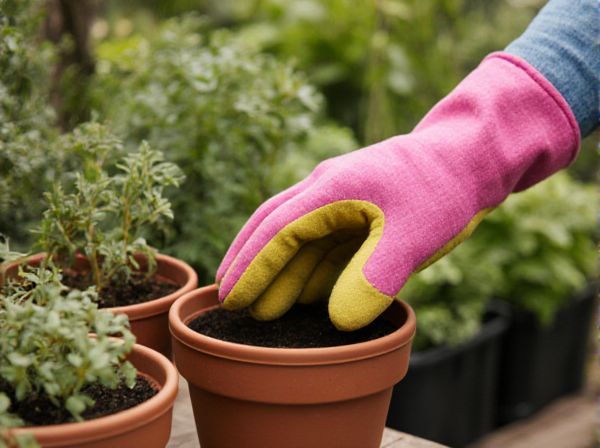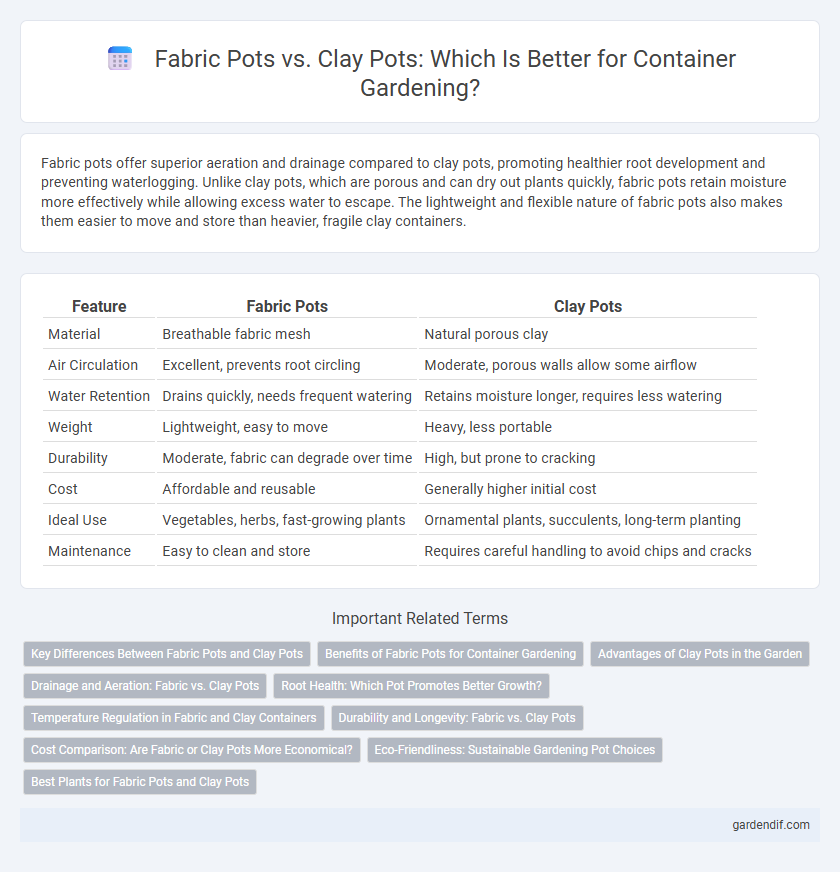
Fabric pots vs clay pots Illustration
Fabric pots offer superior aeration and drainage compared to clay pots, promoting healthier root development and preventing waterlogging. Unlike clay pots, which are porous and can dry out plants quickly, fabric pots retain moisture more effectively while allowing excess water to escape. The lightweight and flexible nature of fabric pots also makes them easier to move and store than heavier, fragile clay containers.
Table of Comparison
| Feature | Fabric Pots | Clay Pots |
|---|---|---|
| Material | Breathable fabric mesh | Natural porous clay |
| Air Circulation | Excellent, prevents root circling | Moderate, porous walls allow some airflow |
| Water Retention | Drains quickly, needs frequent watering | Retains moisture longer, requires less watering |
| Weight | Lightweight, easy to move | Heavy, less portable |
| Durability | Moderate, fabric can degrade over time | High, but prone to cracking |
| Cost | Affordable and reusable | Generally higher initial cost |
| Ideal Use | Vegetables, herbs, fast-growing plants | Ornamental plants, succulents, long-term planting |
| Maintenance | Easy to clean and store | Requires careful handling to avoid chips and cracks |
Key Differences Between Fabric Pots and Clay Pots
Fabric pots offer superior aeration and drainage compared to clay pots, promoting healthier root systems and preventing waterlogging. Clay pots are heavier and porous, providing natural breathability but retaining moisture longer, which can be beneficial in dry climates. While fabric pots are flexible and lightweight, making them easier to move and store, clay pots offer stability and a traditional aesthetic that can enhance garden decor.
Benefits of Fabric Pots for Container Gardening
Fabric pots offer superior aeration and drainage compared to clay pots, promoting healthier root growth and preventing waterlogging in container gardening. Their lightweight and flexible structure makes them easy to move and store, while also encouraging air pruning of roots, which reduces root circling and enhances overall plant development. The breathable material helps maintain optimal soil temperature, fostering a more stable growing environment for container plants.
Advantages of Clay Pots in the Garden
Clay pots offer superior breathability compared to fabric pots, allowing air and moisture to penetrate the porous material, which helps prevent root rot and promotes healthy root growth. Their natural insulation properties protect plant roots from extreme temperature fluctuations, creating a more stable environment for sensitive plants. Additionally, the weight of clay pots provides better stability for larger plants and reduces the risk of tipping over in windy garden conditions.
Drainage and Aeration: Fabric vs. Clay Pots
Fabric pots provide superior drainage and aeration compared to clay pots, as their porous material allows excess water to escape easily while promoting airflow to the root zone, reducing the risk of root rot. Clay pots, made from fired clay, offer moderate drainage through their porous walls but can retain moisture longer, sometimes leading to oversaturation. The breathable nature of fabric pots supports healthier root systems by preventing waterlogging and encouraging oxygen exchange, making them ideal for plants requiring well-drained soil.
Root Health: Which Pot Promotes Better Growth?
Fabric pots promote better root health by allowing superior aeration and drainage, which prevents root rot and encourages robust root branching. Clay pots, while porous and breathable, can retain moisture unevenly, potentially leading to root stress in certain conditions. Research indicates plants in fabric pots often exhibit faster growth and stronger root systems due to enhanced oxygen flow and reduced soil compaction.
Temperature Regulation in Fabric and Clay Containers
Fabric pots offer superior temperature regulation by allowing air to circulate freely through the porous material, preventing overheating and promoting root aeration. Clay pots, with their dense and thick walls, tend to retain heat longer, which can lead to increased soil temperatures and stress on plants during hot weather. The breathable nature of fabric containers ensures a cooler root environment compared to the insulating properties of clay pots, making them preferable for temperature-sensitive plants.
Durability and Longevity: Fabric vs. Clay Pots
Fabric pots offer excellent durability due to their flexible, tear-resistant materials that prevent cracking and breakage, making them ideal for outdoor use and frequent handling. Clay pots, while heavier and more fragile, provide excellent breathability for plant roots but tend to chip, crack, or degrade over time, especially in freezing temperatures. The longevity of fabric pots generally surpasses clay pots as they resist weathering and can be reused multiple planting seasons without significant wear.
Cost Comparison: Are Fabric or Clay Pots More Economical?
Fabric pots generally cost less upfront than clay pots, making them a more economical choice for budget-conscious gardeners. Clay pots, while pricier, offer durability and can last for many years if properly maintained, potentially offsetting their higher initial cost over time. Considering factors like breakage risk, weight, and long-term use is essential when comparing the overall cost-effectiveness of fabric versus clay containers.
Eco-Friendliness: Sustainable Gardening Pot Choices
Fabric pots offer superior eco-friendliness due to their biodegradable materials and reusable nature, reducing plastic waste in gardening. Clay pots, though natural and recyclable, often require more energy-intensive manufacturing and can break easily, leading to more frequent replacements. Choosing fabric pots supports sustainable gardening by promoting soil aeration and water retention while minimizing environmental impact.
Best Plants for Fabric Pots and Clay Pots
Fabric pots excel for growing vegetables like tomatoes, peppers, and herbs due to their superior aeration and drainage, which promote healthier root systems and prevent root rot. Clay pots are ideal for succulents, cacti, and Mediterranean plants such as rosemary and lavender, as their porous nature allows moisture to evaporate, preventing overwatering. Choosing between fabric and clay pots depends on plant water needs, root growth preferences, and environmental conditions for optimal container gardening success.
Fabric pots vs clay pots Infographic

 gardendif.com
gardendif.com